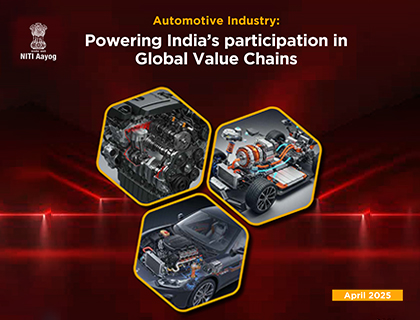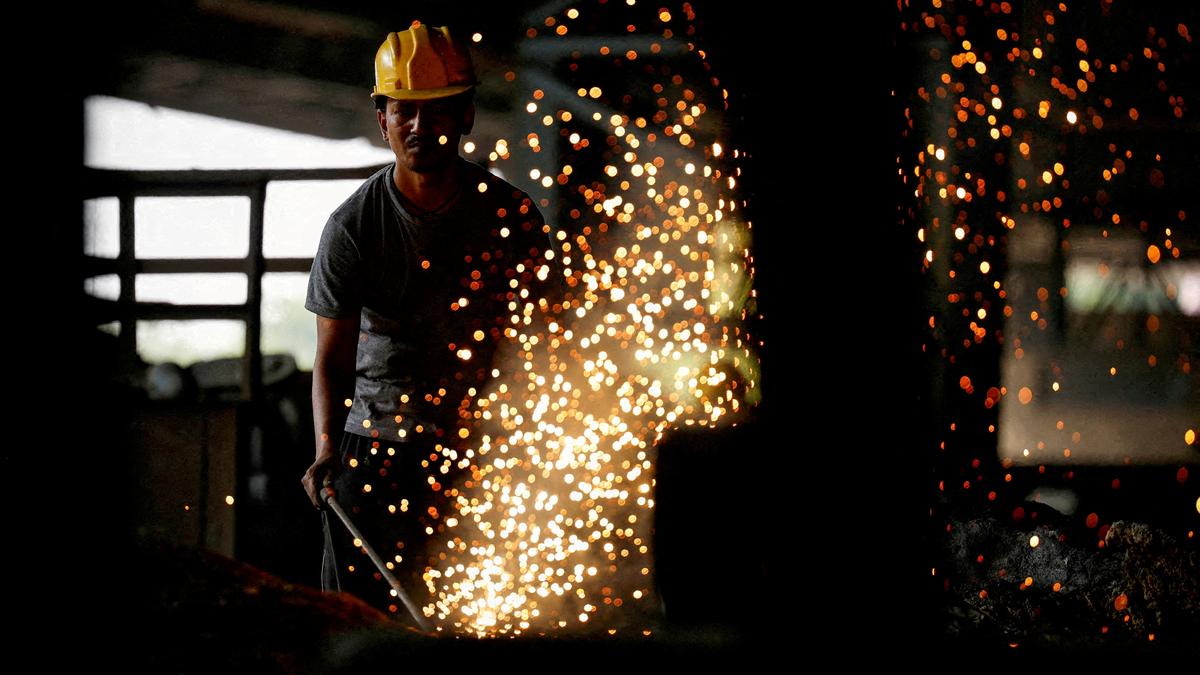India’s Automotive Industry and Global Value Chains

- 14 Apr 2025
In News:
NITI Aayog has recently released a comprehensive report titled “Automotive Industry: Powering India’s Participation in Global Value Chains”. It offers a roadmap to boost India’s role in the global automotive sector by enhancing competitiveness, production capacity, and export potential.
India’s Current Position
India is the world’s fourth-largest automobile producer, with nearly 6 million vehicles manufactured annually. However, its share in the global automotive component trade remains modest at 3%, primarily due to limited penetration in high-precision segments like engine components and drive transmission systems. The country exports auto components worth $20 billion, with major strengths in small cars and utility vehicles.
Global Landscape and Emerging Trends
Globally, 94 million vehicles were produced in 2023, with the automotive components market valued at $2 trillion, of which $700 billion was exported. The industry is witnessing rapid transformation through:
- Electric Vehicles (EVs): Rising demand, regulatory shifts, and battery innovations are reshaping manufacturing.
- Battery Ecosystems: Hubs in Europe and the US are altering global supply chains, focusing on lithium and cobalt.
- Industry 4.0: AI, IoT, robotics, and machine learning are revolutionizing automotive manufacturing through smart factories and digital supply chains.
Challenges to India’s GVC Participation
Despite a strong production base, India faces several hurdles in climbing the Global Value Chain (GVC):
- Low R&D spending and limited innovation
- High operational costs and infrastructural gaps
- Weak IP ecosystem and low brand visibility
- Inadequate skilling and moderate digital adoption
Strategic Interventions Proposed
NITI Aayog recommends a combination of fiscal and non-fiscal measures to address these gaps and strengthen India’s automotive ecosystem.
Fiscal Measures:
- Opex support to scale up production and infrastructure
- Skilling initiatives to build a trained workforce
- R&D incentives and IP transfer support for MSMEs
- Cluster development for shared R&D and testing facilities
Non-Fiscal Measures:
- Promoting Industry 4.0 adoption and quality manufacturing
- Ease of Doing Business reforms in labour, logistics, and regulations
- Global tie-ups and Free Trade Agreements (FTAs) to boost exports
Vision for 2030
By 2030, the report envisions:
- Auto component production to grow from ~$60 billion to $145 billion
- Exports to increase from $20 billion to $60 billion
- GVC share to rise from 3% to 8%
- Trade surplus of around $25 billion
- Employment generation of 2–2.5 million additional jobs
Index of Industrial Production (IIP)

- 14 Apr 2025
In News:
The Index of Industrial Production (IIP), a key barometer of industrial activity in India, registered a growth of just 2.9% in February 2025, the slowest pace in six months. This was below market expectations of around 4% and reflects broad-based slowdown across sectors.
About the IIP
- Published by: Central Statistics Office (CSO), Ministry of Statistics and Programme Implementation (MoSPI)
- Base Year: 2011–12
- Purpose: Measures the short-term changes in volume of production in industrial sectors.
Sectoral Composition and Weights
Sector Weight in IIP No. of Items
Manufacturing 77.63% 809
Mining 14.37% 29
Electricity 7.99% 1
Sector-wise Performance (YoY in February 2025)
Sector Feb 2025 Growth Feb 2024 Growth
Mining 1.6% 8.1%
Manufacturing 2.9% 4.9%
Electricity 3.6% 7.6%
Use-Based Classification Performance
Category Feb 2025 Growth Feb 2024 Growth
Capital Goods 8.2% 1.7%
Intermediate Goods 1.5% —
Consumer Non-Durables -2.1% -3.2%
Observation: Capital goods were the only category to show robust growth. All other segments registered deceleration.
Eight Core Industries (Weight in IIP: 40.27%)
In decreasing order of weight:
- Refinery Products
- Electricity
- Steel
- Coal
- Crude Oil
- Natural Gas
- Cement
- Fertilisers
Key Concerns Highlighted
- Slowing growth across mining, manufacturing, and electricity sectors
- A high base effect from the previous year
- A decline in month-on-month output after five months of sustained growth
- Consumer non-durables in continued contraction, indicating weak rural/household demand
Amrit Bharat Scheme
- 14 Apr 2025
In News:
The Amrit Bharat Station Scheme (ABSS), launched to transform railway stations across India into world-class travel hubs, has achieved a key milestone. Railway Minister Ashwini Vaishnaw announced the completion of redevelopment work at 104 stations out of the planned 1,300 stations under the scheme.
About the Amrit Bharat Station Scheme
- Launched: 2023
- Objective: Comprehensive redevelopment of railway stations to:
- Upgrade passenger amenities
- Enhance multi-modal connectivity
- Modernize infrastructure with sustainable and accessible design
Key Updates (As of April 2025)
- Total stations under ABSS: 1,300
- Stations with completed redevelopment: 104
- Stations in Maharashtra: 132 (significant progress reported)
Major Highlights
Feature Details
Notable Station Project Chhatrapati Shivaji Maharaj Terminus (CSMT), Mumbai
CSMT Redevelopment Cost ?1,800 crore
Modern Facilities Planned Waiting lounges, food courts, clean restrooms, lifts, escalators,
digital signage
International Comparison CSMT post-redevelopment projected to surpass
London’s Kings Cross station
Additional Infrastructure Developments in Maharashtra
- Gondia–Ballarshah Railway Line Doubling:
- Length: 240 km
- Region: Vidarbha
- Approved Investment: ?4,819 crore
- Strategic Importance: Enhances connectivity and freight movement
Centre–State Collaboration
- A Memorandum of Understanding (MoU) was signed between the Government of India and Government of Maharashtra for railway project implementation and coordination.
Beijing+30 India Report

- 14 Apr 2025
In News:
India’s official submission on the Beijing+30 Report marks three decades since the Beijing Declaration and Platform for Action (1995), a landmark framework advancing gender equality across 12 key areas such as education, health, economy, and political participation.
While the report acknowledges past progress—including enactment of laws like the Domestic Violence Act (2005) and the POSH Act (2013)—it lacks an integrated climate-gender perspective, an urgent gap given rising climate vulnerabilities affecting women disproportionately.
Climate Change and Gender Inequality: A Dual Challenge
- Rural women, particularly in agrarian and forest-dependent regions, face acute consequences of climate change—loss of livelihood, food insecurity, and health risks.
- India’s rural women often bear the brunt of extreme weather events, droughts, and resource scarcity.
- According to reports:
- 33% loss of income occurs due to climate-induced productivity disruption, especially from non-farm sources.
- Women perform over 8 hours of daily work, of which 71% is unpaid.
- By 2050, unpaid care work is projected to rise to 8.3 hours/day without mitigation.
Key Data and Impacts
Indicator Insight
Pregnant women (India) 50%+ are anaemic; worsened by food insecurity
Temperature–Violence Link +1°C rise → 8% rise in physical violence, 7.3% rise in sexual violence
Climate policies (FAO) Only 6% mention women; 1% mention poor people
Agriculture Potential Closing gender gap in agri-inputs could raise yields by 20–30%
Women as Agents of Climate Resilience
- Women contribute to 50% of global food production and lead community efforts in seed preservation, sustainable farming, and disaster response.
- Indigenous and rural women prioritize livelihood security (Mahua), safety (Mao), and managing migration—termed the three M's.
- Informal women’s collectives are key in disaster resilience, ecosystem protection, and productivity gains.
Recommendations for Climate-Gender Integration
- Policy Interventions:
- Introduce gender-responsive climate budgeting to prevent greenwashing and ensure equitable allocation.
- Incorporate gender in NAPCC, SAPCC, and ensure percolation to local governance and disaster planning.
- Address emerging risks—trafficking, migration, health, and geriatric safety in disaster zones.
- Data and Monitoring:
- Establish indicators and research on gendered climate impacts.
- Conduct inclusive climate consultations to enable community-driven planning.
- Private Sector & Green Finance:
- Encourage women-led green enterprises, climate-resilient technologies, and inclusive innovations.
- Allocate climate adaptation funds to skill-building, non-farm livelihoods, and local resilience-building.
- Partnership Model:
- Promote collaboration between government, civil society, research institutions, private sector, and international organisations.
- Foster knowledge exchange, capacity building, and public recognition of women climate leaders.
Neutrino Mass and the KATRIN Experiment
- 14 Apr 2025
In News:
The KATRIN experiment nearly halved the maximum possible mass for the subatomic particles.
What are Neutrinos?
- Neutrinos are electrically neutral fundamental particles under the Standard Model of particle physics.
- They are produced in natural processes such as radioactive decay and nuclear reactions in stars and the Sun.
- Notably, they interact very weakly with matter and possess extremely small mass — less than a millionth the mass of an electron.
- Their exact mass is still not directly known, making them a key area of research in modern physics.
The KATRIN Experiment
- Full Form: Karlsruhe Tritium Neutrino Experiment
- Location: Karlsruhe Institute of Technology, Germany
- Objective: To determine the mass of the electron antineutrino, a type of neutrino released during beta decay of tritium.
- Method: By observing the energy spectrum of electrons emitted from tritium decay, scientists infer the mass of the associated neutrino — since more massive neutrinos carry away more energy.
Latest Findings (2025)
- KATRIN has now lowered the upper limit of the neutrino mass to less than 0.45 electron volts (eV).
- This marks a ~50% improvement from its previous estimate, demonstrating enhanced precision in measurements.
- The conclusion was drawn from analysis of 36 million electrons emitted during tritium decay.
